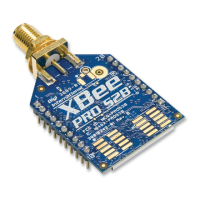Transmission, addressing, and routing RF packet routing
XBee/XBee-PRO ZigBee RF Modules User Guide 63
Many-to-one routing
In networks where many devices must send data to a central collector or gateway device, AODV mesh routing
requires significant overhead. If every device in the network had to discover a route before it could send data to
the data collector, the network could easily become inundated with broadcast route discovery messages.
Many-to-one routing is an optimization for these kinds of networks. Rather than require each device to do its own
route discovery, a single many-to-one broadcast transmission is sent from the data collector to establish reverse
routes on all devices. This is shown in the figure below. The left side shows the many broadcasts the devices can
send when they create their own routes and the route replies generated by the data collector. The right side
shows the benefits of many-to-one routing where a single broadcast creates reverse routes to the data collector
on all routers.
The many-to-one broadcast is a route request message with the target discovery address set to the address of the
data collector. Devices that receive this route request create a reverse many-to-one routing table entry to create
a path back to the data collector. The ZigBee stack on a device uses historical link quality information about each
neighbor to select a reliable neighbor for the reverse route.
When a device sends data to a data collector, and it finds a many-to-one route in its routing table, it will transmit
the data without performing a route discovery. The many-to-one route request should be sent periodically to
update and refresh the reverse routes in the network.
Applications that require multiple data collectors can also use many-to-one routing. If more than one data
collector device sends a many-to-one broadcast, devices will create one reverse routing table entry for each
collector.
In ZB firmware, the AR command is used to enable many-to-one broadcasting on a device. The AR command sets
a time interval (measured in ten second units) for sending the many to one broadcast transmission. See
Command reference tables on page 153 for details.
Source routing
In applications where a device must transmit data to many remotes, AODV routing would require performing one
route discovery for each destination device to establish a route. If there are more destination devices than there
are routing table entries, established AODV routes would be overwritten with new routes, causing route
discoveries to occur more regularly. This could result in larger packet delays and poor network performance.
ZigBee source routing helps solve these problems. In contrast to many-to-one routing that establishes routing
paths from many devices to one data collector, source routing allows the collector to store and specify routes for
many remotes.
To use source routing, a device must use the API firmware, and it must send periodic many-to-one route request
broadcasts (AR command) to create a many-to-one route to it on all devices. When remote devices send RF data
using a many-to-one route, they first send a route record transmission. The route record transmission is unicast
along the many-to-one route until it reaches the data collector. As the route record traverses the many-to-one
route, it appends the 16-bit address of each device in the route into the RF payload. When the route record
reaches the data collector, it contains the address of the sender, and the 16-bit address of each hop in the route.
The data collector can store the routing information and retrieve it later to send a source routed packet to the
remote. This is shown in the images below.
Route request broadcast
Route reply unicast
Data collector
Router

